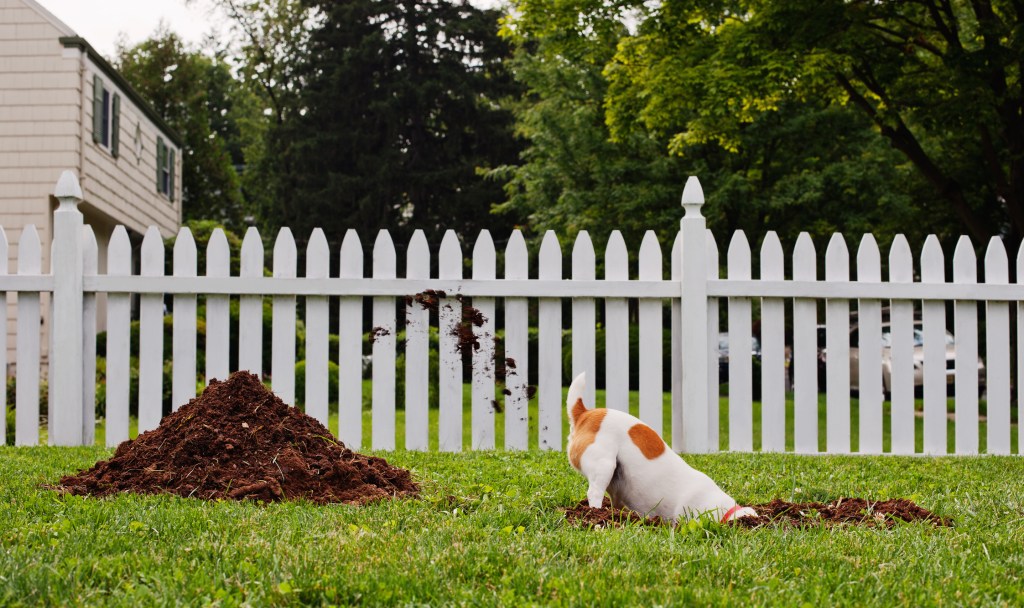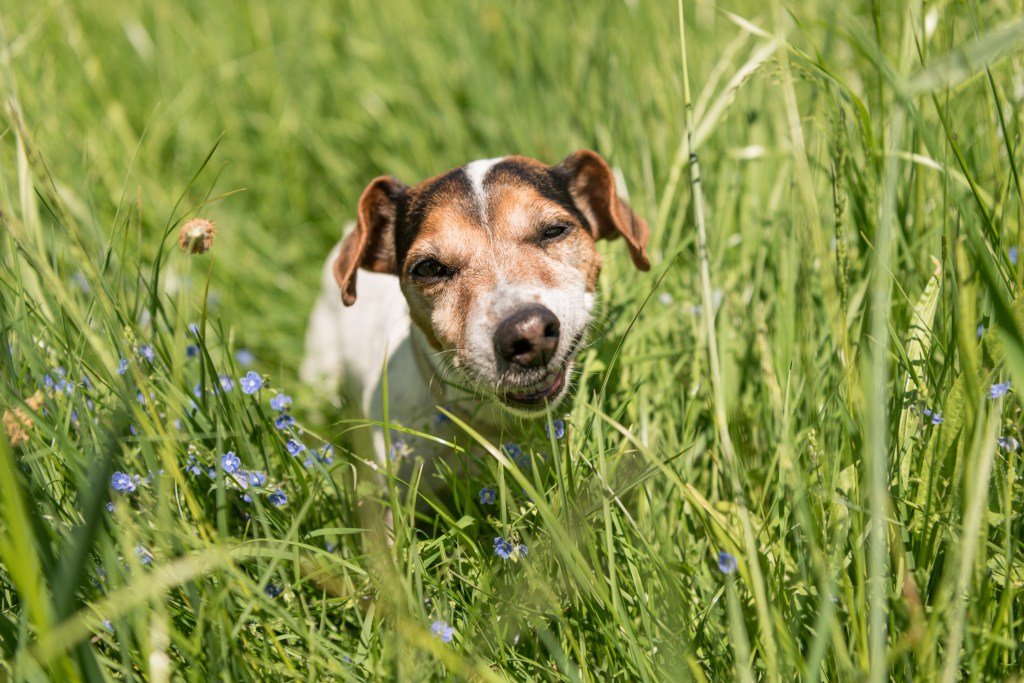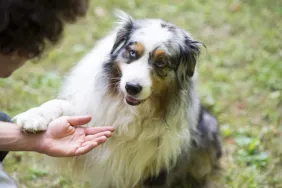From “Why does my dog lick everyone?” to “How do I get an ESA letter for housing?“, there is a wide gamut for the most asked questions about dogs. Whether in an attempt to address a concern or just satiate a general curiosity about our pets’ natural tendencies, we often find ourselves heading straight to Google for answers. Here are some of the most asked dog questions on the internet.
Why do dogs lick you?
Among the trending dog questions, this one may come as a surprise. It likely ranks so high because the seemingly peculiar behavior is a frequently displayed behavior in dog world. Dogs lick people for multiple reasons, such as showing affection, bonding, and exploring their environment through scent and taste. Licking serves as a natural behavior akin to sniffing, allowing dogs to gather information about new individuals they encounter. Additionally, it can signify submission or the desire to seek attention and affection. This may be particularly true if they’ve learned it leads to positive responses from humans. However, excessive licking might indicate underlying stress or anxiety.
How do dogs act when a tornado is coming?
As tornado season approaches, it’s no surprise how dogs react to tornadoes is one of the trending dog questions on Google. Dogs often exhibit signs of restlessness, anxiety, and increased alertness when they sense a tornado or severe storm approaching, including pacing, seeking comfort, and hiding in safe spots. Watch for signs such as panting, drooling, whimpering, or barking, as well as heightened vigilance. To prepare, always monitor the weather during storms, establish a tornado-safe room for your family and pets with crates or carriers, and conduct regular drills to ensure everyone knows what to do when a tornado warning is issued.
Can I give my dog Benadryl?
Hello, pollen! Like humans, dogs can be highly sensitive to seasonal allergies, especially if they’re rolling around in the grass. Benadryl®, an antihistamine, is generally safe for dogs, with minimal side effects and a low risk of overdose when administered correctly. As outlined in the Merck Veterinary Manual, the typical dosage for Benadryl® is 2–4 milligrams per kilogram of body weight, which translates to 0.9–1.8 milligrams (mg) per pound. Hence, a straightforward and effective dosage is 1 mg of Benadryl® per pound of your dog’s weight, administered two to three times daily.
It’s crucial to consult your veterinarian before giving the pill to your dog, especially if they have specific health conditions or are taking certain medications. Instances where Benadryl® should be used cautiously or avoided altogether include cardiac conditions, certain lung disorders, liver disease, seizure disorders, urinary difficulties, glaucoma, pregnancy, and when combined with certain medications like monoamine oxidase inhibitors or drugs used for fungal infections.
How to stop dogs from digging?

If your dog is digging in the yard, it’s likely not an attempt to set booby traps for potential intruders. They may dig for entertainment. Alternatively, they may dig to burn energy, create a burrow for cooling or warming, or follow their hunting instincts. Regardless, you probably don’t want holes in your yard! To discourage digging, ensure your dog gets enough exercise and mental stimulation. Designate a specific digging area, supervise outdoor time, and correct unwanted behavior. Block access to preferred digging spots and make them unappealing with deterrents. Provide suitable shelter and comfort. If digging persists, address underlying issues with a vet or professional trainer.
What can I give my dog for pain?
Nonsteroidal anti-inflammatory drugs (NSAIDs) are effective in reducing swelling, stiffness, post-surgery soreness, and joint pain in both humans and dogs. However, it’s essential to avoid giving human NSAIDs such as ibuprofen or acetaminophen to dogs, as they can be harmful. Instead, consult your veterinarian to find appropriate NSAIDs formulated specifically for dogs, including carprofen (Novox or Rimadyl), deracoxib (Deramaxx), firocoxib (Previcox), meloxicam (Metacam), or grapiprant (Galliprant). Ingesting human NSAIDs like Ibuprofen can lead to poisoning in dogs due to their harmful effects on enzymes like cyclooxygenase, which are crucial for kidney function and stomach protection.
What colors can dogs see?
Dogs primarily see shades of blue, green, and yellow due to the types of color receptors, or cones, in their eyes. Their color vision is less sensitive compared to humans, and they perceive the world in a range of blues and yellows, with shades of gray. Reds and oranges appear more muted to dogs, often appearing as shades of brown or gray.
How much chocolate can kill a dog?
Despite the known dangers of chocolate, this is still one of the internet’s trending dog questions. The toxicity of chocolate for dogs varies depending on the type and amount consumed. Baking chocolate, which is almost pure cocoa, can pose a danger even in small amounts, with just one ounce being over the danger line for a 20-pound dog. For dark chocolate, a scale of 1.5 ounces per 10 pounds of body weight is used, meaning 3 ounces for a 20-pound dog is potentially toxic. Milk chocolate or semi-sweet varieties can be poisonous in amounts exceeding 3.5 ounces, equivalent to a standard-size Hershey’s bar, for a small 10-pound dog. However, white chocolate, containing minimal cocoa, poses less risk of toxicity, though its high sugar content can still be harmful. If a dog ingests chocolate, it’s crucial to contact a veterinarian promptly for advice and possible treatment.
Why is my dog panting?
Dog panting is a natural and common behavior that serves various purposes. One primary reason dogs pant is to regulate their body temperature, as they don’t sweat like humans do. Panting helps them cool down by evaporating moisture from their tongue and respiratory tract. Additionally, dogs pant when they’re excited, anxious, or stressed, as a way to release excess energy or alleviate tension.
Pain or discomfort, such as from illness or injury, can also cause panting in dogs. It’s essential to consider the context and accompanying behaviors when determining why a dog is panting excessively. For example, excessive panting accompanied by trembling may indicate your dog is in pain or maybe severely anxious. If you’re concerned about your dog’s panting, consulting with a veterinarian is advisable to ensure their well-being.
Do dogs dream?

Quoting Shakespeare, “We are such stuff as dreams are made on, and our little life is rounded with sleep.” Well, apparently, the same goes for our pups. To that end, yes, dogs do dream. Scientists have discovered dogs experience various sleep stages, including REM (rapid eye movement) sleep, the stage of sleep where most dreams occur. During this stage, dreams may be accompanied by twitches and vocalizations. You may even catch your pup “running” while they sleep. Interestingly, studies have shown dogs sleep better in familiar surroundings and after physical activity, similar to humans. Additionally, the frequency and duration of a dog’s dreams can vary based on factors such as size and age. Smaller dogs and puppies tend to have shorter, more frequent dreams, occurring approximately every 10 minutes, while larger dogs may have longer dreams, lasting up to about five minutes.
Can I afford a dog?
With the increasing costs associated with dog ownership, it’s no surprise this is one of the trending dog questions when adopting a pet. The main expenses of owning a dog include veterinary care, food, grooming, boarding, and preventive treatments. According to the ASPCA, small dogs incur an estimated monthly cost of $43, medium-sized dogs average around $56 per month, and large dogs have an average monthly expense of $87. However, this monthly budget doesn’t include unforeseen veterinary expenses. It’s advisable to set aside additional funds each month for emergency veterinary care or consider researching pet insurance options, which can provide valuable assistance in times of need.
Why do dogs eat grass?

Questions pertaining to why dogs eat grass are common among veterinarians, as many dogs exhibit this behavior regularly. Eating grass, considered a form of pica, may be linked to a diet lacking in essential nutrients, vitamins, or minerals. However, dogs on balanced commercial diets should theoretically not experience such deficiencies, raising the question of why they engage in this behavior. One prevailing theory is dogs eat grass to alleviate upset stomachs, often followed by vomiting. Yet, studies suggest only a minority of dogs actually vomit after consuming grass, and most do not display signs of illness beforehand. Another possibility is dogs chew grass to fulfill a psychological need, particularly when bored or seeking stimulation in their environment.
Who do dogs eat poop?
The behavior of dogs eating feces, known as coprophagia, can be perplexing and concerning for pet owners. Generally, the reasons are either behavioral or medical. For example, some dogs eat poop due to nutritional deficiencies in their diet. The seemingly strange behavior may result from dogs seeking to obtain nutrients they perceive as lacking. Additionally, boredom, stress, or anxiety, particularly when left alone for extended periods or lacking mental stimulation, may prompt this behavior. In certain cases, coprophagia could be a learned behavior, especially if a dog witnessed another dog in the household engaging in it. Medical conditions like malabsorption disorders or parasites could also play a role.
Veterinary specialists also suggest coprophagia may serve as a means for dogs to gather information about the animal that left the droppings. Dogs possess an olfactory organ called the vomeronasal organ, which allows them to detect the chemical composition of what they’re smelling. By consuming feces, dogs may facilitate the transfer of information to their vomeronasal organ, aiding in the detection of pheromones, diet, species, and other relevant data.
Have a concerning dog question? Call your vet.
Although these responses cover some of the most commonly asked questions about dogs online, this list isn’t exhaustive. Remember, if your inquiries extend beyond mere curiosity and raise concerns about your pet’s well-being, it’s best to reach out directly to your veterinarian instead of relying solely on internet searches for information.









